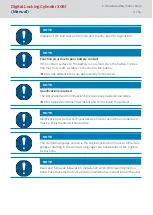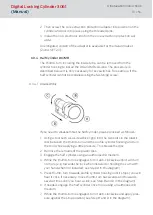
NOTE
The profile cylinder must be protected with a VdS-approved burglar-resist-
ant class B or C door label. Such door plates conform to DIN 18257, Class
ES 2 or ES 3. The cylinder may not protrude more than 3 mm above the
door plate. The scope of burglary-resistant measures is based on the re-
spective national provisions.
This version is available as .MS, .FH and WN versions.
5.10 AP version
A cylinder with an anti-panic function must be fitted to all doors where the
lock's panic function may be adversely affected by the position of the cam.
This version contains an integrated spring mechanism which places the
locking cam in a non-critical position, meaning a panic lock's panic function
cannot be blocked.
In contrast to all other cylinders, the .AP type cylinder is fitted the other way
round with the thumb-turn containing the battery and the electronics
module installed on the outside (see diagram).
Unlike the standard anti-panic cylinder (AP), the inside thumb-turn of
which is permanently engaged, the inside thumb-turn for the freely-
rotating AP version (AP.FD) is disengaged mechanically and cannot be
engaged with an identification medium.
1. Inside thumb-turn
2. Recessed grip ring
3. Battery replacement key
4. Outside thumb-turn
The following aspects should be taken into consideration for doors along
rescue routes which have been installed after April 1, 2003 (exit devices as
per DIN EN 179 or DIN EN 1125): All Locking Cylinder 3061 models may be
used for all exit devices where their approval states that the Locking
Digital Locking Cylinder 3061
(Manual)
5. Versions
20 / 54
















































